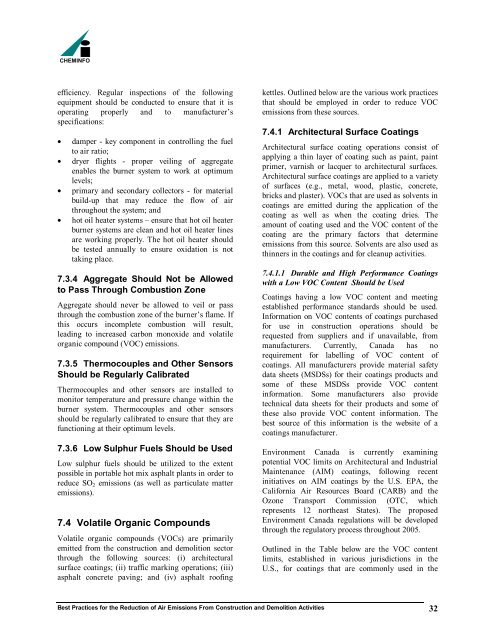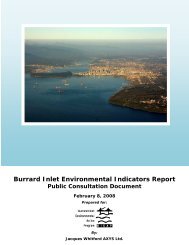Best Practices for the Reduction of Air Emissions From Construction ...
Best Practices for the Reduction of Air Emissions From Construction ...
Best Practices for the Reduction of Air Emissions From Construction ...
Create successful ePaper yourself
Turn your PDF publications into a flip-book with our unique Google optimized e-Paper software.
CHEMINFO<br />
efficiency. Regular inspections <strong>of</strong> <strong>the</strong> following<br />
equipment should be conducted to ensure that it is<br />
operating properly and to manufacturer’s<br />
specifications:<br />
• damper - key component in controlling <strong>the</strong> fuel<br />
to air ratio;<br />
• dryer flights - proper veiling <strong>of</strong> aggregate<br />
enables <strong>the</strong> burner system to work at optimum<br />
levels;<br />
• primary and secondary collectors - <strong>for</strong> material<br />
build-up that may reduce <strong>the</strong> flow <strong>of</strong> air<br />
throughout <strong>the</strong> system; and<br />
• hot oil heater systems – ensure that hot oil heater<br />
burner systems are clean and hot oil heater lines<br />
are working properly. The hot oil heater should<br />
be tested annually to ensure oxidation is not<br />
taking place.<br />
7.3.4 Aggregate Should Not be Allowed<br />
to Pass Through Combustion Zone<br />
Aggregate should never be allowed to veil or pass<br />
through <strong>the</strong> combustion zone <strong>of</strong> <strong>the</strong> burner’s flame. If<br />
this occurs incomplete combustion will result,<br />
leading to increased carbon monoxide and volatile<br />
organic compound (VOC) emissions.<br />
7.3.5 Thermocouples and O<strong>the</strong>r Sensors<br />
Should be Regularly Calibrated<br />
Thermocouples and o<strong>the</strong>r sensors are installed to<br />
monitor temperature and pressure change within <strong>the</strong><br />
burner system. Thermocouples and o<strong>the</strong>r sensors<br />
should be regularly calibrated to ensure that <strong>the</strong>y are<br />
functioning at <strong>the</strong>ir optimum levels.<br />
7.3.6 Low Sulphur Fuels Should be Used<br />
Low sulphur fuels should be utilized to <strong>the</strong> extent<br />
possible in portable hot mix asphalt plants in order to<br />
reduce SO2 emissions (as well as particulate matter<br />
emissions).<br />
7.4 Volatile Organic Compounds<br />
Volatile organic compounds (VOCs) are primarily<br />
emitted from <strong>the</strong> construction and demolition sector<br />
through <strong>the</strong> following sources: (i) architectural<br />
surface coatings; (ii) traffic marking operations; (iii)<br />
asphalt concrete paving; and (iv) asphalt ro<strong>of</strong>ing<br />
kettles. Outlined below are <strong>the</strong> various work practices<br />
that should be employed in order to reduce VOC<br />
emissions from <strong>the</strong>se sources.<br />
7.4.1 Architectural Surface Coatings<br />
Architectural surface coating operations consist <strong>of</strong><br />
applying a thin layer <strong>of</strong> coating such as paint, paint<br />
primer, varnish or lacquer to architectural surfaces.<br />
Architectural surface coatings are applied to a variety<br />
<strong>of</strong> surfaces (e.g., metal, wood, plastic, concrete,<br />
bricks and plaster). VOCs that are used as solvents in<br />
coatings are emitted during <strong>the</strong> application <strong>of</strong> <strong>the</strong><br />
coating as well as when <strong>the</strong> coating dries. The<br />
amount <strong>of</strong> coating used and <strong>the</strong> VOC content <strong>of</strong> <strong>the</strong><br />
coating are <strong>the</strong> primary factors that determine<br />
emissions from this source. Solvents are also used as<br />
thinners in <strong>the</strong> coatings and <strong>for</strong> cleanup activities.<br />
7.4.1.1 Durable and High Per<strong>for</strong>mance Coatings<br />
with a Low VOC Content Should be Used<br />
Coatings having a low VOC content and meeting<br />
established per<strong>for</strong>mance standards should be used.<br />
In<strong>for</strong>mation on VOC contents <strong>of</strong> coatings purchased<br />
<strong>for</strong> use in construction operations should be<br />
requested from suppliers and if unavailable, from<br />
manufacturers. Currently, Canada has no<br />
requirement <strong>for</strong> labelling <strong>of</strong> VOC content <strong>of</strong><br />
coatings. All manufacturers provide material safety<br />
data sheets (MSDSs) <strong>for</strong> <strong>the</strong>ir coatings products and<br />
some <strong>of</strong> <strong>the</strong>se MSDSs provide VOC content<br />
in<strong>for</strong>mation. Some manufacturers also provide<br />
technical data sheets <strong>for</strong> <strong>the</strong>ir products and some <strong>of</strong><br />
<strong>the</strong>se also provide VOC content in<strong>for</strong>mation. The<br />
best source <strong>of</strong> this in<strong>for</strong>mation is <strong>the</strong> website <strong>of</strong> a<br />
coatings manufacturer.<br />
Environment Canada is currently examining<br />
potential VOC limits on Architectural and Industrial<br />
Maintenance (AIM) coatings, following recent<br />
initiatives on AIM coatings by <strong>the</strong> U.S. EPA, <strong>the</strong><br />
Cali<strong>for</strong>nia <strong>Air</strong> Resources Board (CARB) and <strong>the</strong><br />
Ozone Transport Commission (OTC, which<br />
represents 12 nor<strong>the</strong>ast States). The proposed<br />
Environment Canada regulations will be developed<br />
through <strong>the</strong> regulatory process throughout 2005.<br />
Outlined in <strong>the</strong> Table below are <strong>the</strong> VOC content<br />
limits, established in various jurisdictions in <strong>the</strong><br />
U.S., <strong>for</strong> coatings that are commonly used in <strong>the</strong><br />
<strong>Best</strong> <strong>Practices</strong> <strong>for</strong> <strong>the</strong> <strong>Reduction</strong> <strong>of</strong> <strong>Air</strong> <strong>Emissions</strong> <strong>From</strong> <strong>Construction</strong> and Demolition Activities 32
















